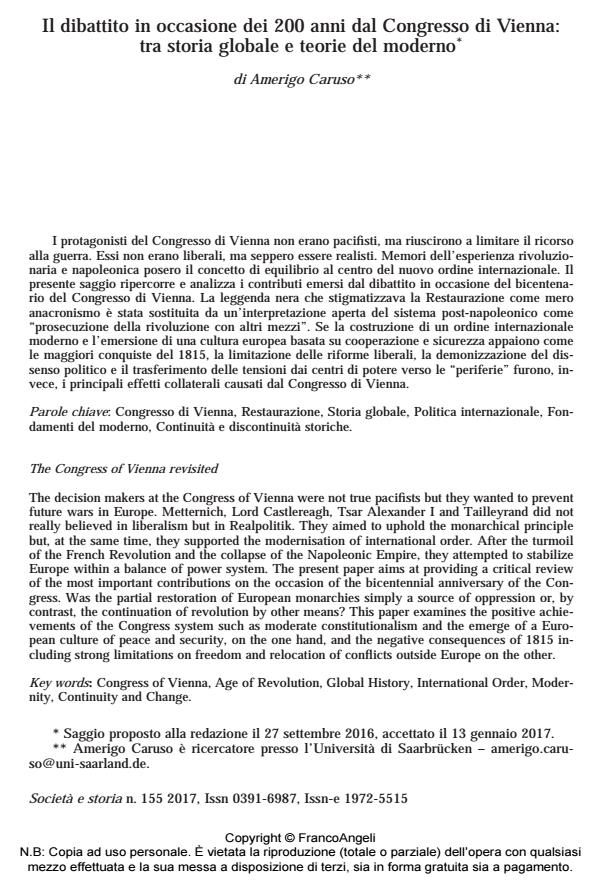The Congress of Vienna revisited
Journal title SOCIETÀ E STORIA
Author/s Amerigo Caruso
Publishing Year 2017 Issue 2017/155
Language Italian Pages 17 P. 167-183 File size 64 KB
DOI 10.3280/SS2017-155007
DOI is like a bar code for intellectual property: to have more infomation
click here
Below, you can see the article first page
If you want to buy this article in PDF format, you can do it, following the instructions to buy download credits

FrancoAngeli is member of Publishers International Linking Association, Inc (PILA), a not-for-profit association which run the CrossRef service enabling links to and from online scholarly content.
I protagonisti del Congresso di Vienna non erano pacifisti, ma riuscirono a limitare il ricorso alla guerra. Essi non erano liberali, ma seppero essere realisti. Memori dell’esperienza rivoluzionaria e napoleonica posero il concetto di equilibrio al centro del nuovo ordine internazionale. Il presente saggio ripercorre e analizza i contributi emersi dal dibattito in occasione del bicentenario del Congresso di Vienna. La leggenda nera che stigmatizzava la Restaurazione come mero anacronismo è stata sostituita da un’interpretazione aperta del sistema post-napoleonico come "prosecuzione della rivoluzione con altri mezzi". Se la costruzione di un ordine internazionale moderno e l’emersione di una cultura europea basata su cooperazione e sicurezza appaiono come le maggiori conquiste del 1815, la limitazione delle riforme liberali, la demonizzazione del dissenso politico e il trasferimento delle tensioni dai centri di potere verso le "periferie" furono, invece, i principali effetti collaterali causati dal Congresso di Vienna.
Keywords: Congresso di Vienna, Restaurazione, Storia globale, Politica internazionale, Fondamenti del moderno, Continuità e discontinuità storiche.
- Quale storia della società? Uno sguardo sull'epoca moderna Paola Bianchi, in SOCIETÀ E STORIA 178/2023 pp.711
DOI: 10.3280/SS2022-178005
Amerigo Caruso, Il dibattito in occasione dei 200 anni dal Congresso di Vienna: tra storia globale e teorie del moderno in "SOCIETÀ E STORIA " 155/2017, pp 167-183, DOI: 10.3280/SS2017-155007